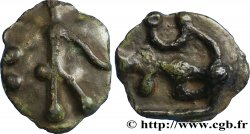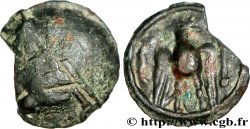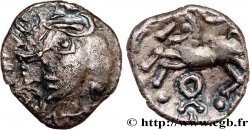v31_0798 - EDUENS, ÆDUI (BIBRACTE, Area of the Mont-Beuvray) Denier à l’esse et à la lyre, tête bouclée
MONNAIES 31 (2007)
Starting price : 220.00 €
Estimate : 380.00 €
Realised price : 255.00 €
Number of bids : 2
Maximum bid : 421.00 €
Starting price : 220.00 €
Estimate : 380.00 €
Realised price : 255.00 €
Number of bids : 2
Maximum bid : 421.00 €
Type : Denier à l’esse et à la lyre, tête bouclée
Date: c. avant 52 AC.
Mint name / Town : Autun (71)
Metal : silver
Diameter : 13 mm
Orientation dies : 2 h.
Weight : 1,97 g.
Rarity : R3
Coments on the condition:
Flan relativement large, mais frappe décentrée au droit (sur l'avant du visage) et au revers (sur la tête du cheval). Fine patine grise, légèrement granuleuse
Catalogue references :
Obverse
Obverse legend : ANÉPIGRAPHE.
Obverse description : Tête à droite, les cheveux en mèches bouclées.
Reverse
Reverse legend : ANÉPIGRAPHE.
Reverse description : Cheval galopant à droite ; lyre au-dessous et une esse au-dessus.
Commentary
Ce denier constitue, dans le Nouvel Atlas, la var. 3 des "quinaires à la lyre" des Eduens. Le DT. 3185 est l'exemplaire de la BN illustré dans le LA TOUR (n° 4866). Le droit a la particularité d'avoir une chevelure simplifiée sans les mèches enroulées à leur extrémité comme c'est habituellement le cas. Les auteurs du Nouvel Atlas précisent que la hampe à la roue est analogue au revers du statère de Chenôves DT. 3175.








 Report a mistake
Report a mistake Print the page
Print the page Share my selection
Share my selection Ask a question
Ask a question Consign / sell
Consign / sell
 Full data
Full data









